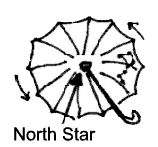BACKGROUND:
When students begin the study of
astronomy, a clear distinction must be made between astronomy and astrology.
Astronomy deals with the study of the location, motion, and nature of
objects in space. Astrology is the interpretation of the influence of the
heavenly bodies on human affairs. Astrology is not a science; its results
are not repeatable nor consistent.
 In
lab, the students will try and locate different objects in the Universe by
learning to read celestial globes. These are projections of the sky onto a
spherical surface, which is called the celestial sphere. Within the
celestial sphere, the north and south celestial poles are points in the sky
that seem fixed. The remaining stars and celestial objects appear to rotate
around them. In the Northern Hemisphere, the celestial pole is marked by
Polaris, the "North Star". To illustrate the celestial poles, you
can use an open umbrella. The pole of the umbrella represents the celestial
pole; the top of it would be the North Star. As you rotate the umbrella, it
shows how the Northern Hemisphere constellations seem to move in the night
sky.
In
lab, the students will try and locate different objects in the Universe by
learning to read celestial globes. These are projections of the sky onto a
spherical surface, which is called the celestial sphere. Within the
celestial sphere, the north and south celestial poles are points in the sky
that seem fixed. The remaining stars and celestial objects appear to rotate
around them. In the Northern Hemisphere, the celestial pole is marked by
Polaris, the "North Star". To illustrate the celestial poles, you
can use an open umbrella. The pole of the umbrella represents the celestial
pole; the top of it would be the North Star. As you rotate the umbrella, it
shows how the Northern Hemisphere constellations seem to move in the night
sky.
A constellation is an apparent
grouping of stars and galaxies, as viewed from Earth. They are often named
for a mythical figure, animal or inanimate object. There are 88 sectors of
the Universe named for constellations. Astronomers use these to locate
sections of the sky. Well-known ones include Orion, Hercules, and Pegasus.
About 8 degrees north and south of the
ecliptic (a band across the sky between the highest (summer) and lowest
(winter) point of the Sun’s apparent path) there are 12 constellations
called the zodiac. Because of the Earth's motion around the Sun, the Sun
appears to pass in front of each zodiacal constellation once per year,
always in the same order. For example, the Sun is at Pisces at the beginning
of spring and then moves through, Aries, Taurus, and so on.
The zodiac constellations serve as
reference points to astronomers when investigating the Universe. However to
astrologers, the zodiac constellations, as well as the motions of the
planets, were signs believed to influence the behavior and lives of people
(i.e., finances, relationships, moods, friendships). There is no
scientific basis for these interpretations.
PROCEDURE:
- Discuss with students the constellations in the sky and how they are
named for mythical figures. Emphasize that the Zodiac
constellations were thought to be special because they were within the
ecliptic. Use the song to emphasize the difference and to locate
the different constellations.
- As a class, see if you can figure out the zodiac signs by using the
birthdays of the students. Most of them probably know their astrological
signs. Write the information on the board, as shown in the table below.